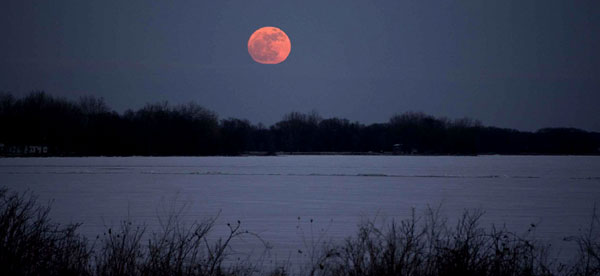By the light of a beautiful moon…
Administrator | Jan 28, 2013 | Comments 0
 The first full moon of 2013 lights up the night sky over Wellington Jan. 26 in this photograph by Ramesh Pooran.
The first full moon of 2013 lights up the night sky over Wellington Jan. 26 in this photograph by Ramesh Pooran.
Native Americans keep track of the seasons by giving distinctive names to each recurring full moon.
Here is a listing of all of the full moon names, as well as the dates and times for 2013. For more details and video, visit: http://www.space.com/19464-full-moon-names-2013.html
Jan. 26, 11:38 p.m. EST —Full Wolf Moon: Amid the zero cold and deep snows of midwinter, the wolf packs howled hungrily outside Indian villages.
Feb. 25, 3:26 p.m. EST —Full Snow Moon: Usually the heaviest snows fall in this month. Hunting becomes very difficult, and, hence, to some tribes this was the Full Hunger Moon.
March 27, 5:27 a.m. EDT —Full Worm Moon: In this month the ground softens and the earthworm casts reappear, inviting the return of the robins. In 2013, this is also the Paschal Full Moon— the first full moon of the spring season. The first Sunday following the paschal moon is Easter Sunday, which will be observed four days later on Sunday, March 31.
April 25, 3:57 p.m. EDT —Full Pink Moon: The grass pink or wild phlox is one of the earliest widespread flowers of the spring. Other names were the Full Sprouting Grass Moon, the Egg Moon and — among coastal tribes — the Full Fish Moon, when the shad come upstream to spawn.
May 25, 12:25 a.m. EDT —Full Flower Moon: Flowers are now abundant everywhere. It was also known as the Full Corn Planting Moon or the Milk Moon.
June 23, 7:32 a.m. EDT —Full Strawberry Moon: Strawberry-picking season peaks during this month.
July 22, 2:16 p.m. EDT—Full Buck Moon: Named for when the new antlers of buck deer push out from their foreheads in coatings of velvety fur. It was also often called the Full Thunder Moon, thunderstorms now being most frequent. Sometimes it’s also called the Full Hay Moon.
Aug. 20, 9:45 p.m. EDT —Full Sturgeon Moon: This large fish of the Great Lakes and other major bodies of water like Lake Champlain is most readily caught at this time. A few tribes knew it as the Full Red Moon, because when the moon rises it looks reddish through a sultry haze. It was also known as the Green Corn Moon or Grain Moon.
Sept. 19, 7:13 a.m. EDT —Full Harvest Moon: Traditionally, this designation goes to the full moon that occurs closest to the autumnal (fall) equinox. The Harvest Moon usually comes in September, but (on average) once or twice a decade it will fall in early October. At the peak of the harvest, farmers can work into the night by the light of this moon.
Oct. 18, 7:38 p.m. EDT —Full Hunters’ Moon: With the leaves falling and the deer fattened, it’s now time to hunt.
Nov. 17, 10:16 a.m. EST —Full Beaver Moon: At this point of the year, it’s time to set beaver traps before the swamps freeze to ensure a supply of warm winter furs. It’s also called the Frosty Moon.
Dec. 17, 4:28 a.m. EST —Full Cold Moon: On occasion, this moon was also called the Moon Before Yule. December is also the month the winter cold fastens its grip. Sometimes this moon is referred to as the Full Long Nights Moon and the term “Long Night” Moon is a very appropriate name because the nights are now indeed long and the moon is above the horizon a long time.
-Joe Rao serves as an instructor and guest lecturer at New York’s Hayden Planetarium. He writes about astronomy for The New York Times and other publications. MORE FROM SPACE.com
Filed Under: Featured Articles
About the Author:
































